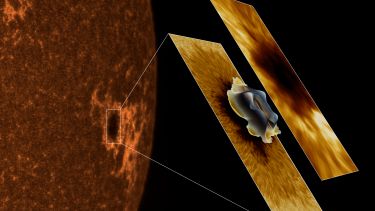- University of Sheffield researchers have developed a new model to understand waves in an unusually large sunspot on the surface of the Sun - three times the diameter of the Earth
- Acoustic waves in stars are often used to determine their size and structure, however this new model confirms that sunspots actually contain an abundance of waves which have both magnetic and acoustic properties
- These findings could help scientists more accurately measure the size of stars and planets outside of our solar system
A major new breakthrough that could help scientists more accurately understand the effect of magnetic fields on the oscillations of stars, has been made by researchers at the University of Sheffield.
In a groundbreaking new study, published in Nature Communications, a team of scientists led by Dr Marco Stangalini from the Italian Space Agency, Dr Gary Verth and Professor Viktor Fedun, both from the University of Sheffield’s Plasma Dynamics Group, has developed a new model that explains waves detected in a large sunspot on the surface of the Sun.
High resolution data captured from the Dunn Solar Telescope in New Mexico has now provided clear evidence that sunspots contain a rich variety of waves, which have both magnetic and acoustic characteristics, known as magneto-acoustic waves. The Plasma Dynamics Group at Sheffield developed a new model to successfully match the data.
The sunspot, which is approximately three times the diameter of the Earth, is unusually large for the Sun but it is still much smaller than the largest spots on other stars. Results from the study suggest that current acoustic wave models used to determine the size and structure of stars outside of our solar system would be improved by taking into account the effect of magneto-acoustic waves inside large starspots.
Dr Gary Verth from the University of Sheffield’s School of Mathematics and Statistics and a member of the Plasma Dynamics Group, said: “It is really thanks to our collaborator Dr Marco Stangalini from the Italian Space Agency who started this by gathering and processing such excellent data, providing for the first time, clear evidence of abundant magneto-acoustic oscillations in a particularly large sunspot. He contacted members of the Plasma Dynamics Group here in Sheffield because of our expertise in the theory and modelling of solar magneto-acoustic waves.
“However, no existing models were accurate enough to match the high resolution observational data so we had to take a completely new approach. This involved inputting the exact cross-sectional shape of the sunspot into our computations.
“Our research team was ecstatic when we found that our model and the observational data were in excellent agreement and we are the first solar scientists to confirm the existence of over thirty predicted wave modes in a sunspot.”
Professor Viktor Fedun from the University of Sheffield’s Department Automatic Control and Systems Engineering and also a member of the Plasma Dynamics Group, added: “What we discovered through this research is that the frequency power spectrum of the rich variety of magneto-acoustic oscillations inside the sunspot have a completely different character to the spectrum of the Sun’s global acoustic oscillations. In fact, the structure of the frequency spectrum of the sunspot has a far more complex nature, creating challenging new questions to answer for solar researchers.
“Our findings also have important implications for astrophysicists who interpret the frequency power spectra of stars that are far more magnetically active than the Sun using purely acoustic models.
“We have demonstrated, using the Sun as a star, that in such cases the Doppler signal could be strongly influenced by the presence of large starspots, which can be hundreds of times larger than sunspots. Since accurate astroseismology is also key for determining the size of exoplanets our results will certainly have an impact on other major astrophysical research areas outside of solar science.”
The study, Large scale coherent magnetohydrodynamic oscillations in a sunspot, has been published in Nature Communications. Read the paper.
Contact
For further information please contact:



